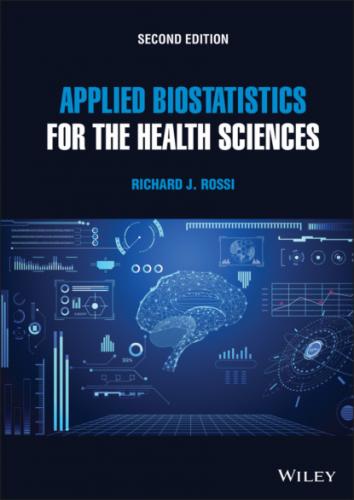Applied Biostatistics for the Health Sciences. Richard J. Rossi
The most commonly used percentiles of the standard normal are given in Table 2.12, and a more complete list of the percentiles of the standard normal distribution is given in Table A3. Note that for p < 50 the percentiles of a standard normal are negative, for p = 50 the 50th percentile is the median, and for p > 50 the percentiles of a standard normal are positive.
Table 2.12 Selected Percentiles of a Standard Normal Distribution
| p | 1 | 5 | 10 | 20 | 25 | 50 |
| pth percentile | −2.33 | −1.645 | −1.28 | −0.84 | −0.67 | 0.00 |
| p | 75 | 80 | 90 | 95 | 99 | 99.9 |
| pth percentile | 0.67 | 0.84 | 1.28 | 1.645 | 2.33 | 3.09 |
When X is a normal distribution with μ≠0 or σ≠1, the distribution of X is called a non-standard normal distribution. The standard normal distribution is the reference distribution for all normal distributions because all of the probabilities and percentiles for a non-standard normal can be determined from the standard normal distribution. In particular, the following relationships between a non-standard normal with mean µ and standard deviation σ and the standard normal can be used to convert a non-standard normal value to a Z-value and vice versa.
THE RELATIONSHIPS BETWEEN A STANDARD NORMAL AND A NON-STANDARD NORMAL
1 If X is a non-standard normal with mean µ and standard deviation σ, then Z=(X−μ)/σ.
2 If Z is a standard normal, then X=σ⋅Z+μ is a non-standard normal with mean µ and standard deviation σ.
Note that the value of a non-standard normal X can be converted into a Z-value and vice versa. The first equation shows that centering and scaling the values of X converts them to Z-values, and the second equation shows how to convert a Z-value into an X-value. The relationship between a standard normal and a non-standard normal is shown in Figure 2.29.
Figure 2.29 The correspondence between the values of a standard normal and a non-standard normal.
To determine the cumulative probability for the value of a non-standard normal, say x, convert the value of x to its corresponding z value using z=z−μ/σ; then determine the cumulative probability for this z value. That is,
To compute probabilities other than a cumulative probability for a non-standard normal, note that the probability of being in any region can also be computed from the cumulative probabilities associated with the standard normal. The rules for computing the probabilities associated with a non-standard normal are given below.
NON-STANDARD NORMAL PROBABILITIES
If X is a non-standard normal variable with mean µ and standard deviation σ, then
1 P(X≥x)=1−P(X≤x) =1−P(Z≤x−μσ)
2 P(a≤X≤b)=P(X≤b)−P(X≤b) =P(Z≤b−μσ)−P(Z≤a−μσ)
Note that each of the probabilities associated with a non-standard normal distribution is based on the process of converting an x value to a z value using the formula Z=(x−μ)/σ. The reason why the standard normal can be used for computing every probability concerning a non-standard normal is that there is a one-to-one correspondence between the Z and X values (see Figure 2.29).
Example 2.38
Suppose X has a non-standard normal distribution with mean µ = 880 and standard deviation σ = 140. The probability that X is between 700 and 1000 is represented by the area shown in Figure 2.30.
Figure 2.30 P(700≤X≤1000).
Converting the X values to Z-values leads to the corresponding probability, P(−1.29≤Z≤0.86), for the standard normal shown in Figure 2.31.
Figure 2.31 The Z region corresponding to 700≤X≤1000.
Example 2.39
The distribution of IQ scores is approximately normal with µ = 100 and σ = 15. Using this normal distribution to model the distribution of IQ scores,
1 an IQ score of 112 corresponds to a Z-value of
2 the probability of having an IQ score of 112 or less is
3 the probability of having an IQ score between 90 and 120 is
4 the probability of having an IQ score of 150 or higher is
Example 2.40
In the article “Distribution of LDL particle size in a population-based sample of children and adolescents and relationship with other cardiovascular risk factors” published in Clinical Chemistry (Stan et al., 2005), the authors reported the results of a study on the peak particle size of low-density lipoprotein (LDL) in children and adolescents. It is known that smaller more dense particles (≤255 Å) of LDL are associated with cardiovascular disease.
The distribution of peak particle was reported to be approximately normal with mean particle size µ = 262 Å and standard deviation σ = 4 Å. Based on this study, the probability that a child or adolescent will have a peak particle size of less than 255 Å is
Thus, there is only a 4% chance that a child or adolescent will have peak particle size less than 255 Å.
2.4.3 Z Scores
The result of converting a non-standard normal value, a raw value, to a Z-value is a Z score. A Z score is a measure of the relative position a value has within its distribution. In particular, a Z score simply measures how many standard deviations a point is above or below the mean. When a Z score is negative the raw value lies below the mean of its distribution, and when a Z score is positive the raw value lies
